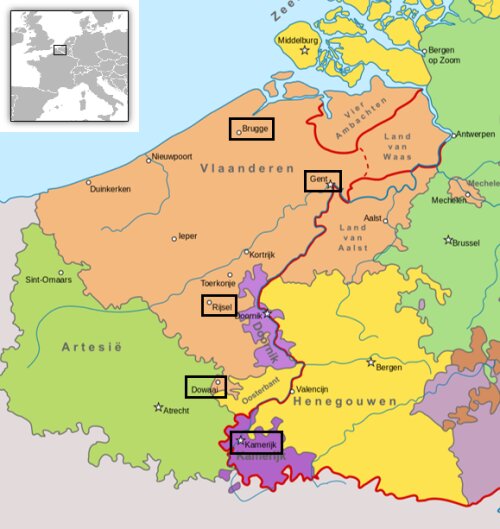Late medieval county of Flanders
The studied region, the County of Flanders in the 14th century, is characterised by a highly urbanised landscape. Together with northern-Italy, it is considered as the most urbanised region in late medieval Europe. Through the dense river systems of the Scheldt and Lys, the major Flemish cities were closely connected with each other. Flanders is therefore a suitable laboratory for looking at how large cities were coping with high food prices and dearth periods. Four large Flemish cities (and one just outside of the county) left a considerable amount of sources in order to analyse this.

The County of Flanders before it went over in Burgundy in 1384. Source image: Wikimedia Commons.
Bruges was a major trading hub in the northern part of the county. It was connected to the North Sea and the international trade through the Zwin inlet. Through the influx of English and Scottish wool, its textile industry developed significantly from the 11th century onwards. A demographic boom followed in the 12th century. In the 13th and especially the 14th century, the industry converted from a textile-centre towards a diversified pallet specialising in luxury products and confection, with the presence of a huge amount of commercial capital. Ghent, the second largest late medieval city north of the Alps, also had an important textile industry, upon which a lot of the wealth of the city was founded on. Additionally, the city held a staple right for the grain trade over the river Scheldt. This means that grain merchants who wanted to transport their goods through the city had to offer their goods for a certain period before they could continue their journey.
The southern part of the county is represented by Lille and Douai. After the Franco-Flemish War (1297-1305) these eponymous castellanies (together with Orchies) were yielded as warranty to the French king for a large part of the 14th century (1305-1369). The textile industry in both Lille and Douai was flourishing early on. Through respectively the Deûle (flows into the Lys) and the Scarpe (flows into the Scheldt), Lille and Douai were connected to the northern-Flemish region. In addition, both cities were embedded in the grain producing region of nowadays northern-France.
Cambrai and the Cambrésis is the last city and region involved in this study, and a more peculiar one due to its location outside of the county and being under the authority of the Holy Roman Empire. It acted as a natural point of distribution of the northern-French grain produced on the plains of the Cambrésis, and was linked to Flanders through the Scheldt river system that reached Ghent further downstream.
Due to their position in the county, the five case studies had an important role in the late medieval Flemish grain trade. Bruges as an international trade hub, Ghent with its vital grain staple and the cities of Lille, Douai and especially Cambrai were embedded in the rich grain-producing plain of nowadays northern-France.